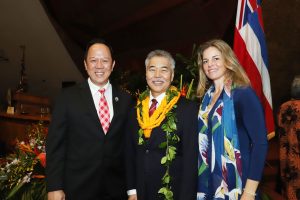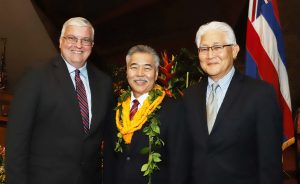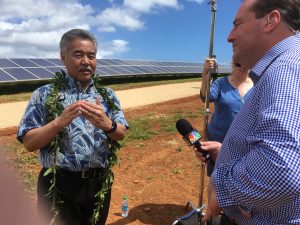Partnering and taking the lead for a Sustainable Hawai’i
Posted on Jan 30, 2019 in Capitol Connection, FeaturedIn addition to preserving important conservation and agricultural lands, under the Sustainable Hawai‘i Initiative, we have established strong guidelines to protect our watershed forests, better manage our oceans, strengthen invasive species prevention through our bio-security plan, double our local food production, and achieve 100 percent renewable energy by 2045.
Our budget includes $3.9 million over two years for Sustainable Hawai‘i initiatives, to support our biosecurity plan, watershed protection and our Agricultural Loan Revolving Fund. And speaking of sustainability, I would be remiss if I didn’t mention that last November, Hawai‘i was designated one of the United Nation’s first Local 2030 sustainability hubs—the first and only such forum in the Pacific. I would like to thank Hawai‘i Green Growth and The Kamehameha Schools for their work in achieving this designation. They are highlighting our achievements and helping to establish Hawai‘i as a leader in sustainability in the Pacific.
Private companies are investing in Hawai‘i to help us meet our sustainability goals. For example, Ampaire has a memorandum of understanding with Mokulele Airlines to deploy an electric airplane on Maui. CarbonCure is working with the Hawaii DOT, HC&D, and Hawaii Gas to develop carbon infused concrete to lower the carbon dioxide emitted during the construction process.
Our public utilities have also made great progress in transitioning to a renewable energy future. Earlier this month, Kaua‘i Island Utilities Co-op announced it has reached 50 percent renewable generation and believes it can reach 70 percent renewable energy a full 10 years ahead of schedule. In the last 10 years, Hawaiian Electric Companies have reduced fossil fuel used to generate electricity by 26 percent—that’s 48 million fewer gallons of imported oil a year. The companies have also pioneered technology to integrate more renewable energy into the electrical grid, and delegations from around the world are coming to Hawai‘i to learn from our experience.
In agriculture, we are entering a new age of innovation, one that will bring new jobs and opportunities and decrease our reliance on imported foods. The future of agriculture relies on producing crops more efficiently and with less impact on the environment. Farmers are constructing cutting-edge greenhouses, using automated production systems, and analyzing data to increase crop yields. These modern practices will require new skills and a workforce grounded in science- and math-related education. Companies like Costco want to build high-tech greenhouses and use these new agricultural techniques in Hawai‘i to complement the food production of local farmers and replace fruits and vegetables from out of state.


